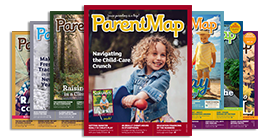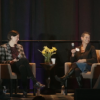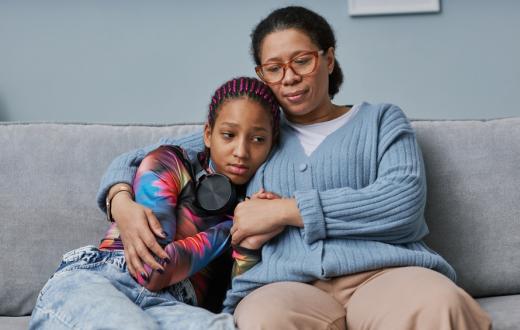
Photo:
Xavier Mouton/Unsplash
Note: This article is primarily geared toward parents of children with the verbal understanding at or above that of a typical 4-year-old, but some of the ideas may be adapted for other children.
TikTok. Playground chatter. Outdated books. Or, heaven forbid, hushed adult conversations about fear of the future. As a psychologist, I hear about the many ways kids first learn about their autism. For parents, it’s hard to know where to start, but it’s easy to want to be the one to talk about it. You love your kid and you want what’s best for them.
I once led a focus group with autistic young men on this topic of learning about a diagnosis of autism. They didn’t agree on everything, but they all emphatically agreed on a few don’ts:
- Don’t act like it is terrible news.
- Don’t make it a big deal.
- Definitely don’t make it a deep, dark secret.
Research backs them up. When autistic children aren’t told why they’re different, they tend to come up with their own negative reasons. Trying to hide the truth about an autism diagnosis tends to backfire, leading to depression and anxiety for the child. You have the power to make a difference in your child’s identity.
So, where to start? What to say? Each child is different, so you will need to decide your own way to go about it. But here are some tips:
Start with yourself.
Learning that your child is autistic can open the gates to a flood of feelings. Relief, happiness, fear, guilt, sadness — there’s no one right way to feel. Your experience will depend on your child’s age, developmental level and how much you already know.
It might help to get some support by talking to friends and family members or by joining a support group (e.g., through The Arc of Washington State). Take some time to learn about autism on your own.
Embrace the idea of neurodiversity; having different types of brains is a natural and valuable part of our world.
Consider reading positive books about autism, such as “Sincerely, Your Autistic Child: What People on the Autism Spectrum Wish Their Parents Knew About Growing Up, Acceptance, and Identity,” edited by Emily Paige Ballou, and “Uniquely Human: A Different Way of Seeing Autism” by Barry Prizant, Ph.D. Check out websites featuring the voices and perspectives of autistic adults who speak from a lifetime of experience, such as Neuroclastic and the Autistic Self Advocacy Network.
Embrace gratitude.
It may be helpful to start by exploring ways in which your child’s diagnosis or the characteristics of their autism help you feel grateful. Do you enjoy your child’s unique perspective? Their passionately pursued interests? Did the diagnosis open a new way of understanding your child and how you can help them thrive? This can be part of a formal gratitude practice or it can just be an informal way to think about things.
Some people celebrate the chance to be part of a new vibrant, supportive and dynamic community. Some people celebrate autism in other ways. Consider doing something tangible. You could bake a cake. Buy your child a gold infinity necklace. Purchase T-shirts for your family. This is a new beginning.
Be creative.
Is your child into science? A lot of scientists are autistic! Some of them even research autism. Is your child more into dinosaurs or My Little Pony or hip-hop? Wouldn’t it be boring if all of the characters, animals and dinosaurs were the same? You can explain that your child is unique, just as they are. Use music, art or memes to support your point.
For many autistic children, their special interests are their world. Have fun embracing ways to explore them!
Start early and don’t stop.
It’s best to start the discussion as early as possible. If you’re the first one to talk about it, you get to frame it positively. Make autism a part of everyday conversations — both casual and frequent. Not heavy. An ongoing theme can be an understanding and celebrating of different types of brains (neurodiversity).
For young kids, there are lots of storybooks to get you started. These are two of my favorites:
- “Ada Twist, Scientist” by Andrea Beaty is a story about a misunderstood scientist whose challenging characteristics turn out to be her greatest strengths. There’s also an animated Netflix series based on the book.
- “Wiggles, Stomps and Squeezes Calm My Jitters Down” by Lindsey Rowe Parker offers a positive take on stimming, or repetitive behaviors.
Older kids and teens might respond better to these titles:
- “Welcome to the Autistic Community” by the Autistic Self Advocacy Network
- “The Guide to the Autistic Mind” is free and comes in two formats: simple and more complex.
- “The Awesome Autistic Go-To Guide: A Practical Handbook for Autistic Teens and Tweens” is a helpful resource written by two autistic authors, Yenn Purkis and Tanya Masterman.
Find more booklists of inclusive children’s books about autism and neurodiversity on the websites Not an Autism Mom and Raising Luminaries.
Ask them what they know.
Your children may know more than you do about certain experiences! But there are also a lot of myths out there. Debunk them supportively. Let them know that learning about their particular experience of autism will be an ongoing adventure that you will navigate together. Check in regularly to find out what is new in their journey of understanding themselves as autistic people.
Explain that no two autistic people are the same, but they usually have some things in common.
Here are some examples of how you can tailor this message for your child: Autistic people have different ways of interacting:
- Autistic people often like to connect by sharing their interests and may talk a lot about them. This is sometimes referred to as “infodumping.”
- Autistic people sometimes connect better with other autistic people. Non-autistic people sometimes have trouble understanding an autistic person’s way of interacting, but communication barriers can be overcome.
- Autistic people might miss some ordinary social cues, but they may have their own creative ways of expressing themselves.
- Some autistic people don’t use spoken language, but they can communicate in other ways. Just because someone doesn’t speak, doesn’t mean they aren’t smart.
- Sometimes autistic people are less likely to go along with what everyone else is doing. And that can be a good thing!
Autistic people have different habits and interests:
- Stimming is the term for how some autistic people move their bodies in different ways to help them feel better.
- Autistic people see, hear and feel things around them in different ways than other people. This can make certain clothing or sounds unbearable, but it can also lead to intense joy from certain types of sights, sounds and sensations. This sensitivity can also make autistic people more creative.
- Autistic people might be super passionate about their interests, which is a huge strength, but it can sometimes be a challenge if they need to think about something else.
- Some autistic people like to follow schedules and have particular habits. This characteristic might make it harder for them to adjust to change, but it makes it easier for them to stick to a plan.
Validate the difficulties that they have.
Your autistic child probably has noticed that certain tasks are harder for them than for others. Or they might like to do tasks in a different way. That’s okay. Explain that other people who have struggled with some of the same issues have learned ways to make life easier. We can all learn from books and websites, and from autistic people who have written about their experiences and scientists who have done research on autism (including autistic scientists!). Your child’s opinions count — they know what works for them and what doesn’t. Value their feedback.
Talk about strengths.
There are lots of good things about being autistic. Here are a few examples. Autistic people:
- are less likely to give in to peer pressure.
- have an ability to stick to a plan and thrive on routine.
- possess a deep passion for their interests. (Older kids might want to learn about a fancy concept called monotropism.)
- demonstrate a strong sense of justice.
- are independent.
- pick up on cues that other people miss.
- are great at organizing certain types of information.
- are honest and direct communicators.
- demonstrate cognitive strengths in visual perception, spatial awareness and mechanical inclination.
Seek out autistic role models.
Get to know some real-life role models in your community! A quick and easy way to do that is online.
- Sign your child up for an Outschool class called “What Is Autism?” with Gabrielle Hughes.
- Join Facebook groups such as Autism Inclusivity and That Au-Some Book Club.
- Participate in trainings at The Arc led by autistic people. You can watch previous trainings and learn about new ones online and the University of Washington Autism Center’s website.
- Listen to autistic people’s stories and learn about famous autistic people, such as Grant Blasko, Michael McCreary, Hannah Gadsby and Eric Garcia.
Explain bias.
The world has been designed for people who are not autistic, so certain aspects of life may be harder for your autistic child. Other people may not always understand autism, but the world is changing. Your child might need to help people “get it.” You’re there to help. If a flower isn’t growing well, you don’t change the flower, you change the environment. A couple of resources:
- “Winnie and Wilbur” by Valerie Thomas tells the story of a witch who tries to change her cat’s color to better suit her. Eventually she gives in and changes the environment. It is a fun way for children to learn about the social model of disability.
- The Neuroclastic website also has some great articles on this topic. Older children might be interested in reading about biases in research and then attempting to spot some of the biases in other places.
Incorporate your child’s culture.
What other aspects of your child’s identity should you consider?
Race. Is your child Black? Find Black autistic role models and read about their experiences (e.g., Facebook pages such as Fidgets and Fries and The Black Autist; podcasts such as Autism in Black; and websites such as Neuroclastic’s Black Autistic Lives Matter). Locally, Open Doors for Multicultural Families has lots of resources for families of all different cultures.
Religion. For example, are you a Christian? Maybe you can read 1 Corinthians 12:14–17 and discuss how we need many different parts for a whole body to work. Or you can follow people such as The Autism Pastor on social media or read his book “Disability and the Church.” Is your family Jewish? Some people incorporate symbols of neurodiversity into the seder plate. If that is consistent with your beliefs, it might be a great option!
Gender identity. Autistic children are also more likely to be gender-diverse. Finn Gratton, LMHC, a nonbinary autistic therapist, provides helpful links, a book and consultation on this topic.
Give your child control.
Let your autistic child know that even though autism is nothing to be ashamed of, they can decide how to describe themselves and when. It is usually important for teachers, doctors and therapists to know when someone is autistic, but children can have more control over who else to tell and the timing.
Encourage your child to ask questions.
Encourage them to raise their questions as new situations arise. If you don’t know an answer, just admit, “I don’t know, but I will help you find out.” Then, do the research together. Ask autistic adults, read and talk to clinicians.
Enjoy the journey and always be ready to learn something new!
Acknowledgement: Sara Woods would like to acknowledge Lucas Harrington, Psy.D., and Annette Estes, Ph.D., for important contributions to this article as well as the support of the University of Washington Autism Center.
Editor's note: This article was first published in February 2002 and has been updated for 2023.











